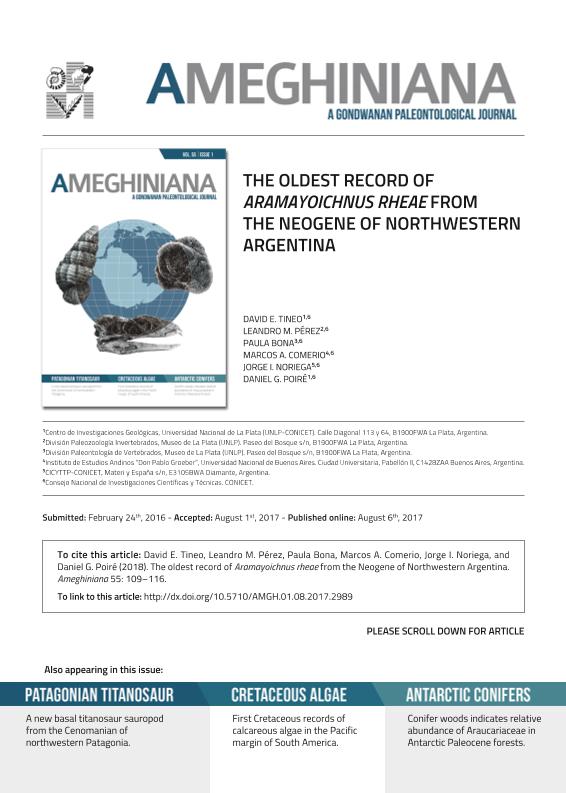Artículo
The Oldest Record of Aramayoichnus rheae from the Neogene of Northwestern Argentina
Tineo, David ; Pérez, Leandro Martín
; Pérez, Leandro Martín ; Bona, Paula
; Bona, Paula ; Comerio, Marcos
; Comerio, Marcos ; Noriega, Jorge Ignacio
; Noriega, Jorge Ignacio ; Poire, Daniel Gustavo
; Poire, Daniel Gustavo
 ; Pérez, Leandro Martín
; Pérez, Leandro Martín ; Bona, Paula
; Bona, Paula ; Comerio, Marcos
; Comerio, Marcos ; Noriega, Jorge Ignacio
; Noriega, Jorge Ignacio ; Poire, Daniel Gustavo
; Poire, Daniel Gustavo
Fecha de publicación:
02/2018
Editorial:
Asociacion Paleontologica Argentina
Revista:
Ameghiniana
ISSN:
0002-7014
e-ISSN:
1851-8044
Idioma:
Inglés
Tipo de recurso:
Artículo publicado
Clasificación temática:
Resumen
THE Argentinean fossil record of vertebrate footprints is significant and has been extensively studied; however, sites with bird tracks are scarce and less known (Bonaparte, 1965; Aramayo, 1991, 2007; Galli et al., 1992; Aramayo and Manera de Bianco, 1987, 1990, 1996; de Valais and Melchor, 2008; Genise et al., 2009; Melchor, 2009; Alonso, 2012; Aramayo et al., 2015). Although there are some studies of fossil footprints referred to Aves, there are no detailed descriptions or taxonomical assignations of such traces. A bird trackway with three footprints was found in the lower levels of the Guandacay Formation (upper MiocenePliocene) (Ayaviri, 1967), Grupo Chaco (Stebinger, 1920; White, 1925), at the “Río Iruya” section, 62 Km NW of the city of San Ramón de la Nueva Orán (Salta Province, Argentina; Fig. 1.1). This unit is part of the fill of the Neogene foreland basin of Sierras Subandinas Australes. This Subandean terrain is a thin-skinned fold-thrust belt system which represents the easternmost expression of the deformation of the central Andes. Compressive tectonics created a foreland basin with clastic sequences of continental rocks of approximately 7500 m of thickness (Hernández et al., 1996; Ramos, 1999). The aim of this contribution is to report a new record of Aramayoichnus rheae Aramayo et al., 2015, from the Neogene of Northwestern Argentina, based on tridactyl footprints attributed to bird activity. This fossil evidence expands the paleogeographical and temporal distribution of this ichnospecies, showing the presence of rheids in the Late Miocene of the Subandean region. The footprints were preserved as natural casts (convex hyporeliefs) in brownish-grey, fine to medium grain conglomerates; the base of the level is in contact with reddishreddish brown mudstones and very fine sandstones (Fig. 1.2). The hypothesis that a rheiform bird could have registered this trackway is herein considered in association with the fossil record of the group in a stratigraphic and biogeographic context.
Palabras clave:
Argentina
,
Guandacay Formation
,
Ichnology
,
Rheidae
,
Salta Province
Archivos asociados
Licencia
Identificadores
Colecciones
Articulos(CCT - LA PLATA)
Articulos de CTRO.CIENTIFICO TECNOL.CONICET - LA PLATA
Articulos de CTRO.CIENTIFICO TECNOL.CONICET - LA PLATA
Articulos(CICYTTP)
Articulos de CENTRO DE INV.CIENT.Y TRANSFERENCIA TEC A LA PROD
Articulos de CENTRO DE INV.CIENT.Y TRANSFERENCIA TEC A LA PROD
Articulos(CIG)
Articulos de CENTRO DE INVEST.GEOLOGICAS (I)
Articulos de CENTRO DE INVEST.GEOLOGICAS (I)
Articulos(IDEAN)
Articulos de INSTITUTO DE ESTUDIOS ANDINOS "DON PABLO GROEBER"
Articulos de INSTITUTO DE ESTUDIOS ANDINOS "DON PABLO GROEBER"
Citación
Tineo, David; Pérez, Leandro Martín; Bona, Paula; Comerio, Marcos; Noriega, Jorge Ignacio; et al.; The Oldest Record of Aramayoichnus rheae from the Neogene of Northwestern Argentina; Asociacion Paleontologica Argentina; Ameghiniana; 55; 1; 2-2018; 109-116
Compartir
Altmétricas



